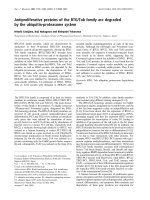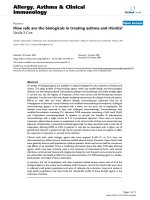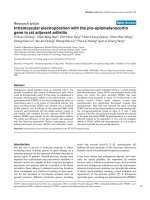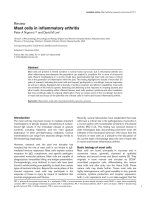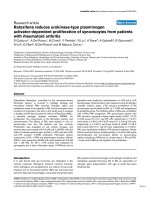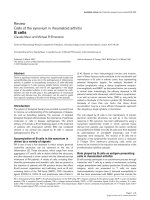Báo cáo y học: "Mast cells are the main interleukin-17-positive cells in anti-citrullinated protein antibody-positive and -negative rheumatoid arthritis and osteoarthritis synovium" pps
Bạn đang xem bản rút gọn của tài liệu. Xem và tải ngay bản đầy đủ của tài liệu tại đây (1.55 MB, 18 trang )
This Provisional PDF corresponds to the article as it appeared upon acceptance. Copyedited and
fully formatted PDF and full text (HTML) versions will be made available soon.
Mast cells are the main interleukin-17-positive cells in anti-citrullinated protein
antibody-positive and -negative rheumatoid arthritis and osteoarthritis synovium
Arthritis Research & Therapy 2011, 13:R150 doi:10.1186/ar3466
Jolien Suurmond ()
Annemarie L Dorjee ()
Mariette R Boon ()
Edward F Knol ()
Tom WJ Huizinga ()
Rene EM Toes ()
Annemie JM Schuerwegh ()
ISSN 1478-6354
Article type Research article
Submission date 8 March 2011
Acceptance date 20 September 2011
Publication date 20 September 2011
Article URL />This peer-reviewed article was published immediately upon acceptance. It can be downloaded,
printed and distributed freely for any purposes (see copyright notice below).
Articles in Arthritis Research & Therapy are listed in PubMed and archived at PubMed Central.
For information about publishing your research in Arthritis Research & Therapy go to
/>Arthritis Research & Therapy
© 2011 Suurmond et al. ; licensee BioMed Central Ltd.
This is an open access article distributed under the terms of the Creative Commons Attribution License ( />which permits unrestricted use, distribution, and reproduction in any medium, provided the original work is properly cited.
Mast cells are the main interleukin-17-positive cells in anti-citrullinated protein
antibody-positive and -negative rheumatoid arthritis and osteoarthritis synovium
Jolien Suurmond
1,#
,
Annemarie L Dorjée
1
, Mariëtte R Boon
1
,
Edward F Knol
2
,
Tom W J
Huizinga
1
,
René E M Toes
1
and Annemie J M Schuerwegh
1
.
1
Department of Rheumatology, Leiden University Medical Center, PO BOX 9600
Albinusdreef 2 – C1-R, 2300 RC Leiden, The Netherlands
2
Department of Dermatology/Allergology, University Medical Center Utrecht,
Heidelberglaan 100, 3584 CX Utrecht, The Netherlands
#
Corresponding author:
Abstract
Introduction: Mast cells have been implicated to play a functional role in arthritis,
especially in autoantibody-positive disease. Among the cytokines involved in rheumatoid
arthritis (RA), interleukin (IL)-17 is an important inflammatory mediator. Recent data
suggest that the synovial mast cell is a main producer of IL-17, although T cells have also
been implicated as prominent IL-17 producers as well. We aimed to identify IL-17
expression by mast cells and T cells in synovium of arthritis patients.
Methods: Synovial samples of anti-citrullinated protein antibody-positive (ACPA) and -
negative RA and osteoarthritis (OA) patients were stained for IL-17 in combination with
CD117 (mast cells), CD3 (T cells) and CD68 (macrophages). Concentrations of IL-17 in
synovial fluid were determined by ELISA.
Results: The number of IL-17+ cells in synovium is comparable in all groups. Although
the vast majority of IL-17+ cells are mast cells, no difference in the percentage of IL-17+
mast cells was observed. Nonetheless, levels of IL-17 in synovial fluid were increased in
ACPA+ RA compared to ACPA- RA and OA patients.
Conclusions: The synovial mast cell is the main IL-17+ cell in all three arthritis groups
analyzed. These data are relevant for studies aimed to block IL-17 in the treatment of
arthritis.
Introduction
Rheumatoid arthritis (RA) is an autoimmune disease characterized by chronic
inflammation of the synovial lining of the joint. In the majority of patients with
established RA, antibodies against citrullinated proteins (ACPA) can be found [1]. It is
currently believed that ACPA+ and ACPA− RA are two different disease entities, each
with their own pathogenesis [2].
Several cell types of the immune system play a role in the pathogenesis of RA. The
presence of autoantibodies and the linkage of RA to HLA shared epitope alleles in
ACPA+ RA indicate that the adaptive immune system plays a prominent role. However,
cells of the innate immune system, such as mast cells have also been implicated in
pathogenesis of RA [3]. Indeed, the number of mast cells in synovial tissue is associated
with inflammatory mediators such as histamine in synovial fluid [4].
Among the cytokines that are thought to be involved in RA, IL-17 has recently attracted
considerable attention. IL-17 can induce production of other proinflammatory factors
such as IL-6, IL-1, tumor necrosis factor (TNF), and matrix metalloproteinases leading to
inflammation, breakdown of cartilage and bone erosion [5]. IL-17 deficient mice are less
prone to develop experimental arthritis and blocking IL-17 can reduce both the onset and
progression in these models [6]. In RA, high levels of IL-17 were found in synovial fluid,
especially compared to OA patients [7]. The first proof-of-concept trial indicates that
neutralization of IL17 is a potential new target for the treatment of RA [8].
Based upon the data described above, it is postulated that Th17 cells, through production
of IL-17 and other Th17-associated cytokines, play a prominent role in the inflamed
synovium by perpetuating the inflammatory milieu observed in arthritis [6]. Interestingly,
a recent study by Hueber et al. indicates that the mast cell is the most abundant cell type
expressing IL-17 in synovial tissue of 10 RA patients [9]. However, other studies have
shown IL-17 producing T cells in RA patients [10].
Because it has been described that ACPA+ and ACPA- RA represent distinct disease
entities [2] we aimed to analyze which cell subsets express IL-17 in synovial tissue of
ACPA+ RA, ACPA- RA and OA patients.
Materials and methods
Patient samples
Synovial tissues were obtained from established ACPA+ (n=34) and ACPA- (n=25) RA
patients who underwent therapeutic arthroscopic lavage of an inflamed knee or knee
replacement surgery. Synovial tissues from established OA patients (n=29) were obtained
from knee replacement surgery. Tissues were fixed by 4% formaldehyde in PBS and
stored in 70% ethanol and embedded in paraffin. Written informed consent was obtained,
and the study was approved by the Leiden University Medical Center human ethics
committee.
Synovial fluid was collected from established ACPA+ RA (n=30) and ACPA- RA
patients (n=29) and established OA patients (n=14) and stored at -20°C until analysis.
Patient diagnoses for RA and OA were fulfilled according to American College of
Rheumatology criteria.
Immunohistochemistry
Synovial tissues were treated according to Schuerwegh et al. [11] Slides were
preincubated with 10% blocking buffer (10% normal horse serum / 10% normal human
serum in PBS) for 20 min and stained with polyclonal goat anti-human IL-17A (0.50
µg/ml; R&D Systems) in 1% blocking buffer (1% normal horse serum / 1% normal
human serum in PBS/1%BSA) for 1 h. For control sections, matching isotype control
(normal goat IgG, Merck) was used. Detection was performed using horse α-goat biotin
(Vector Laboratories), Avidin Biotinylated peroxidase Complex (ABC vectastain Elite
kit, Vector Laboratories) and diaminobenzidine tetrahydrochloride-nickel chloride
(Vector Laboratories).
For combined staining of IL-17 with CD117, CD3, CD4 or CD68, slides were stained for
1 h with polyclonal rabbit anti-human CD117 (23 µg/ml; Dako), monoclonal mouse anti-
human CD3 (2.8 µg/ml; Dako), monoclonal mouse anti-human CD4 (7 ug/ml; Dako),
monoclonal mouse anti-human CD68 (0.51 µg/ml; Dako) or matching isotype control
(rabbit polyclonal Ig; mouse IgG1, Dako) in 1% blocking buffer. Detection of anti-
CD117, -CD3, -CD4 or -CD68 was performed using alkaline phosphatase-conjugated
anti rabbit/mouse Ig and Liquid Permanent Red (Envision α-mouse/rabbit-AP Permanent
Red kit; Dako). The tissue sections were counterstained with haematoxylin.
Stained sections were coded and randomly analyzed. The mean number of single- and
double-positive cells in 10 high-power fields (×400 magnification) was scored blindly by
two observers.
Immunoassay for IL-17
Concentrations of IL-17A in synovial fluid were measured with ELISA (Peprotech)
according to the manufacturer's instructions.
Statistical analysis
Differences between patient and control groups were analyzed using the Kruskal-Wallis
and Mann-Whitney U tests. In all tests, P values less than 0.05 were considered
significant.
Results
To determine the expression of IL-17 by mast cells, T cells and macrophages in synovial
tissue, immunohistochemical stainings were performed in synovial tissue sections of
ACPA+ RA, ACPA- RA and OA patients (table 1).
Representative examples of the staining are shown in figure 1. Isotype controls were
negative (data not shown).
The median number of IL-17+ cells was slightly higher in ACPA+ RA compared to
ACPA- RA and OA patients, but this was not statistically significant (figure 2A).
Likewise, the total number of CD117+ cells was slightly higher in ACPA+ RA patients,
although not statistically significant. There was no difference in the number of T cells
(CD3+) or macrophages (CD68+) between the groups.
To identify the source of IL-17 in synovium, double stainings of IL-17 with CD117 (mast
cells), CD3 (T cells) and CD68 (macrophages) were performed. Interestingly, almost all
IL-17 expressing cells were CD117+, both in synovium of ACPA+ and ACPA- RA as
well as OA patients. Only a small fraction of IL-17+ cells were CD3+ or CD68+ (table
1). Furthermore, there were no differences in these percentages between the three groups.
Because CD3 can be downregulated on activated T cells, we performed additional
staining of IL-17 in combination with CD4 on 6 synovium samples (figure 1D). The
median (range) percentage of IL-17+ cells that were CD4+ was 0.4% (0.0-11.0%). The
median (range) percentage of CD4+ cells that were IL-17+ was 0.1% (0.0-0.7%).
Together, these data indicate that IL-17 in synovium is predominantly expressed by mast
cells.
Since immunohistochemistry does not reveal secretion of IL-17, an ELISA was
performed with synovial fluid of RA and OA patients. ACPA+ RA patients had
significantly higher levels of IL-17 in synovial fluid, compared to ACPA- RA and OA
patients (figure 2B).
Discussion
In this study we show in a relatively large group of 59 RA and 29 OA patients that the
majority of IL-17+ cells are mast cells and not T cells or macrophages. Interestingly,
levels of IL-17 in synovial fluid were increased in ACPA+ RA patients. Because the
expression of IL-17 in synovial tissue correlates strongly with the number of mast cells, it
is conceivable that the increased level of IL-17 in synovial fluid of ACPA+ RA patients
results from the increased activity of mast cells in ACPA+ RA patients. Our data also
showed that IL-17 is not increased in all ACPA+ RA patients. Preliminary analysis of the
characteristics of the RA patients with high number of IL-17 producing cells show that
these patients tend to have higher serum ACPA-titers and erythrocyte sedimentation rate
at the time of diagnosis.
In this study, mast cells were identified as CD117+ cells. As described in Schuerwegh et
al., flow cytometric staining of synovial tissue revealed that all CD117+ cells express
FcεRI and/or IgE [11]. Therefore, CD117 alone can be considered as a good mast cell
marker in synovial tissue.
Although our results suggest that mast cells are the most prominent producers of IL-17 in
synovial tissue, a clear limitation of this study is that only the expression of IL-17 was
studied and not active secretion. We do not know whether IL-17 is secreted by activated
mast cells, as we were unable to isolate viable mast cells from synovial tissue.
Nonetheless, Hueber et al. showed IL-17 secretion by in vitro cultured mast cells,
indicating that mast cells can readily produce IL-17 [9]. Because the samples of synovial
fluid, in which higher levels of IL-17 were found, were from different patients than the
samples of synovial tissue, it is unclear whether the increased levels of IL-17 correlate
directly to the presence of IL-17+ mast cells in the same synovial tissue.
It was previously found by our group that IgE-ACPA can bind to FcεRI on basophils and
that citrullinated proteins can directly activate basophils of ACPA+ RA patients. In
addition, an increased number of degranulated mast cells was shown in synovium of
ACPA+ RA patients, indicating a higher activity of mast cells in ACPA+ RA patients
[11]. Because mast cells also express FcεRI, it is tempting to speculate that mast cells
were also activated by citrullinated proteins present in the joint, thereby releasing IL-17
that contributes to the inflammatory milieu present in the inflamed synovium. However,
there was no difference in the expression of IL-17 between ACPA+ and ACPA- RA
patients. Therefore, it is unclear whether the more activated state of mast cells that was
found before [11] can be related to release of IL-17, as in this study we were only able to
evaluate expression of IL-17 rather than secretion.
Several studies have provided evidence indicating that also IL-17 producing T cells in
synovial tissue or fluid contribute to inflammation. However, these T cells are not
abundantly present in the synovial compartment. Indeed, even after strong non-specific T
cell triggering only a small minority (~1-10%) of CD4+ T cells obtained from synovial
fluid or synovial tissue produces IL-17, as shown by flow cytometry [10,12,13,14].
Furthermore, the antigen specificity of these Th17 cells in synovium is unknown,
therefore, these cells can also be innocent bystanders that do not contribute to
inflammation in the joint in vivo. In two studies using immunohistochemical staining, IL-
17+ cells were identified as CD3+. However, it is unclear how these results relate to our
study, as in those studies cells were identified using single stainings of consecutive
sections, and the positive cells in the overlaying sections were not quantified, making it
difficult to compare these results contradicting our study.[15,16] Two other studies using
microscopic analysis show that almost no CD3+ T cells in the synovium express IL-17.
In agreement with our study, the cell types that did express IL-17 were found to be
mainly mast cells in one study.[9] However, the other study identified them as being
mainly neutrophils and neutrophil precursors in synovium of the facet joints.[17] Because
we found the mast cells to be the main cell subset expressing IL-17 in synovium from the
knee, it is possible that the cells expressing IL-17 might be different depending on the site
of the joint.
Because production of IL-17 is highly restricted by transcriptional control via
RORgammaT that is also known to regulate the production of other Th17-associated
cytokines, mast cells might also produce other Th17-related cytokines, such as IL-22.
Furthermore, because mast cells can produce many other cytokines as well, blocking the
activation of mast cells for instance via preventing their activation via the FcεRI through
anti-IgE treatment might lead to even more profound effects than blocking IL-17 alone in
arthritis patients. Indeed, blocking of TNF is a very successful therapy in RA and mast
cells are known to be important producers of TNF [18].
Conclusions
Our results show that IL-17 is mainly expressed by mast cells in synovial tissue of both
ACPA+ and in ACPA- RA, as well as in OA patients. Possibly, selective activation of
mast cells in ACPA+ RA is responsible for the increased levels of IL-17 in synovial fluid.
These data are relevant for new targeted therapies in arthritis, such as IL-17 blockade or
the inhibition of mast cell activation.
Abbreviations
ACPA: anti-citrullinated protein antibodies; OA: osteoarthritis; RA: rheumatoid arthritis;
TNF: tumor necrosis factor.
Competing interests
The authors declare that they have no competing interests.
Authors’ contributions
JS carried out experiments, performed statistical analysis and drafted the manuscript, AD
and MB carried out experiments and contributed to the design and analysis of the study ,
EK, TH, RT and AS participated in the design and analysis of the study and helped to
draft the manuscript. All authors read and approved the final manuscript.
Acknowledgements
J. Suurmond’s work is supported by the Dutch Arthritis foundation. A.J.M. Schuerwegh’s
and R.E.M. Toes’ work are supported by the Dutch Organization for Scientific Research
(clinical fellow and VICI grants). A.J.M. Schuerwegh’s work is supported by the
Research Foundation Sole Mio and the Leiden Research Foundation (STROL). This work
is further supported by a grant from the Centre for Medical Systems Biology (CMSB)
within the framework of the Netherlands Genomics Initiative (NGI), FP06 AUTOCURE
and FP07 MASTERSWITCH.
References
1. Schellekens GA, Visser H, de Jong BA, van den Hoogen FH, Hazes JM, Breedveld
FC, van Venrooij WJ: The diagnostic properties of rheumatoid arthritis
antibodies recognizing a cyclic citrullinated peptide. Arthritis Rheum 2000,
43:155-163.
2. Huizinga TW, Amos CI, van der Helm-van Mil AH, Chen W, van Gaalen FA,
Jawaheer D, Schreuder GM, Wener M, Breedveld FC, Ahmad N, Lum RF, de Vries
RR, Gregersen PK, Toes RE, Criswell LA: Refining the complex rheumatoid
arthritis phenotype based on specificity of the HLA-DRB1 shared epitope for
antibodies to citrullinated proteins. Arthritis Rheum 2005, 52:3433-3438.
3. Lee DM, Friend DS, Gurish MF, Benoist C, Mathis D, Brenner MB: Mast cells: a
cellular link between autoantibodies and inflammatory arthritis. Science 2002,
297:1689-1692.
4. Malone DG, Irani AM, Schwartz LB, Barrett KE, Metcalfe DD: Mast cell numbers
and histamine levels in synovial fluids from patients with diverse arthritides.
Arthritis Rheum 1986, 29:956-963.
5. Miossec P, Korn T, Kuchroo VK: Interleukin-17 and type 17 helper T cells. N Engl
J Med 2009, 361:888-898.
6. Lubberts E: IL-17/Th17 targeting: on the road to prevent chronic destructive
arthritis? Cytokine 2008, 41:84-91.
7. Ziolkowska M, Koc A, Luszczykiewicz G, Ksiezopolska-Pietrzak K, Klimczak E,
Chwalinska-Sadowska H, Maslinski W: High levels of IL-17 in rheumatoid
arthritis patients: IL-15 triggers in vitro IL-17 production via cyclosporin A-
sensitive mechanism. J Immunol 2000, 164:2832-2838.
8. Genovese MC, Van den Bosch F, Roberson SA, Bojin S, Biagini IM, Ryan P, Sloan-
Lancaster J: LY2439821, a humanized anti-interleukin-17 monoclonal antibody,
in the treatment of patients with rheumatoid arthritis: A phase I randomized,
double-blind, placebo-controlled, proof-of-concept study. Arthritis Rheum 2010,
62:929-939.
9. Hueber AJ, Asquith DL, Miller AM, Reilly J, Kerr S, Leipe J, Melendez AJ, McInnes
IB: Mast cells express IL-17A in rheumatoid arthritis synovium. J Immunol 2010,
184:3336-3340.
10. Gullick NJ, Evans HG, Church LD, Jayaraj DM, Filer A, Kirkham BW, Taams
LS: Linking power Doppler ultrasound to the presence of th17 cells in the
rheumatoid arthritis joint. PLoS One 2010, 5:e12516-1 - e12516-11.
11. Schuerwegh AJ, Ioan-Facsinay A, Dorjee AL, Roos J, Bajema IM, van der Voort
EI, Huizinga TW, Toes RE: Evidence for a functional role of IgE anticitrullinated
protein antibodies in rheumatoid arthritis. Proc Natl Acad Sci U S A 2010,
107:2586-2591.
12. Pene J, Chevalier S, Preisser L, Venereau E, Guilleux MH, Ghannam S, Moles JP,
Danger Y, Ravon E, Lesaux S, Yssel H, Gascan H: Chronically inflamed human
tissues are infiltrated by highly differentiated Th17 lymphocytes. J Immunol
2008, 180:7423-7430.
13. Nistala K, Moncrieffe H, Newton KR, Varsani H, Hunter P, Wedderburn LR:
Interleukin-17-producing T cells are enriched in the joints of children with
arthritis, but have a reciprocal relationship to regulatory T cell numbers.
Arthritis Rheum 2008, 58:875-887.
14. Yamada H, Nakashima Y, Okazaki K, Mawatari T, Fukushi JI, Kaibara N, Hori
A, Iwamoto Y, Yoshikai Y: Th1 but not Th17 cells predominate in the joints of
patients with rheumatoid arthritis. Ann Rheum Dis 2008, 67:1299-1304.
15. Stamp LK, Easson A, Pettersson L, Highton J, Hessian PA: Monocyte derived
interleukin (IL)-23 is an important determinant of synovial IL-17A expression in
rheumatoid arthritis. J Rheumatol 2009, 36:2403-2408.
16. Chabaud M, Durand JM, Buchs N, Fossiez F, Page G, Frappart L, Miossec P:
Human interleukin-17: A T cell-derived proinflammatory cytokine produced by
the rheumatoid synovium. Arthritis Rheum 1999, 42:963-970.
17. Appel H, Maier R, Wu P, Scheer R, Hempfing A, Kayser R, Thiel A, Radbruch
A, Loddenkemper C, Sieper J: Analysis of interleukin-17+ cells in facet joints of
patients with spondyloarthritis suggests that the innate immune pathway might
be of greater relevance than the Th17 mediated adaptive immune response.
Arthritis Res Ther 2011, 13:R95 [epub ahead of print]
18. McLachlan JB, Hart JP, Pizzo SV, Shelburne CP, Staats HF, Gunn MD, Abraham
SN: Mast cell-derived tumor necrosis factor induces hypertrophy of draining
lymph nodes during infection. Nat Immunol 2003, 4:1199-1205.
Tables
Table 1: Expression of IL-17 by mast cells, T cells and macrophages in synovial
tissue
ACPA+RA
(n = 34)
ACPA-RA
(n = 25)
OA
(n = 29)
P
value
Age (years) 55 (32-80) 63 (19-80) 67 (42-83)
Gender (female/male) 22/12 14/11 21/8
Disease duration (years) 7 (0-28) 8 (0-24) unknown
Median n
o
IL-17+ cells 21 (0-118) 12 (1-61) 17 (0-50) 0.381
% of IL-17+ that is MC 97 (40-100)
96 (0-100) 93 (0-100) 0.969
% of IL-17+ that is T cell 0 (0-100) 0 (0-24) 2 (0-49) 0.558
% of IL-17+ that is MØ 0 (0-78) 4 (0-100) 1 (0-58) 0.382
Median n
o
MC 28 (0-123) 19 (0-92) 25 (0-76) 0.198
% MC (CD117+) expressing IL-17 91 (13-100)
83 (0-100) 96 (4-100) 0.599
Median n
o
T cells (CD3+) 21 (0-592) 10 (0-115) 11 (0-265) 0.609
% T cells (CD3+) expressing IL-17 0 (0-60) 0 (0-66) 1 (0-78) 0.149
Median n
o
MØ (CD68+) 71 (1-390) 53 (1-302) 66 (2-231) 0.634
% MØ (CD68+) expressing IL-17 0 (0-16) 0 (0-14) 0 (0-11) 0.689
Results are expressed as median (minimum-maximum). Mast cells are defined as
CD117+ cells, T cells are defined as CD3+ cells and macrophages are defined as CD68+
cells.
ACPA: anti-citrullinated protein antibody; MC: mast cell; MØ: macrophage; OA:
osteoarthritis; RA: rheumatoid arthritis.
Figure legends
Figure 1. Expression of IL-17 by immunohistochemistry.
A. Double-staining of IL-17 (black) and CD117+ mast cells (pink). B. Double-staining of
IL-17 (black) and CD68+ macrophages (pink) C. Double-staining of IL-17 (black) and
CD3+ T cells (pink). D. Double-staining of IL-17 (black) and CD4 (pink). Representative
examples are shown. Arrows indicate double-positive cells, arrowheads indicate single
IL-17+ cells.
Figure 2. IL-17 in synovial tissue and synovial fluid.
A. Number of IL-17+ cells in synovial tissue of ACPA- and ACPA+ RA and OA
patients. Results are expressed as number of cells assessed in 10 high-power fields at
400x magnification. B. Levels of IL-17 in synovial fluid determined by ELISA. *
indicates statistically significant difference (p<0.05), ** indicates statistically significant
difference (p<0.01).
ACPA, anti-citrullinated protein antibody; OA, osteoarthritis; RA, rheumatoid arthritis.




